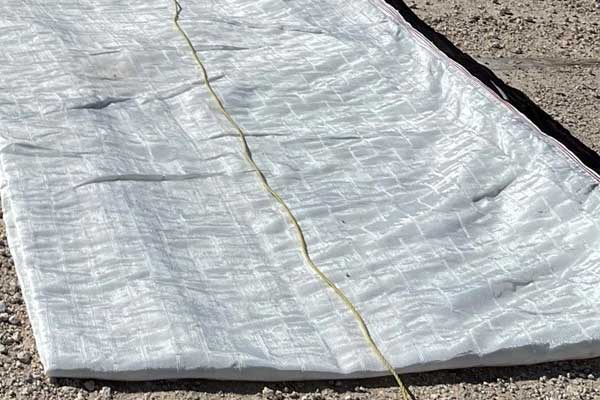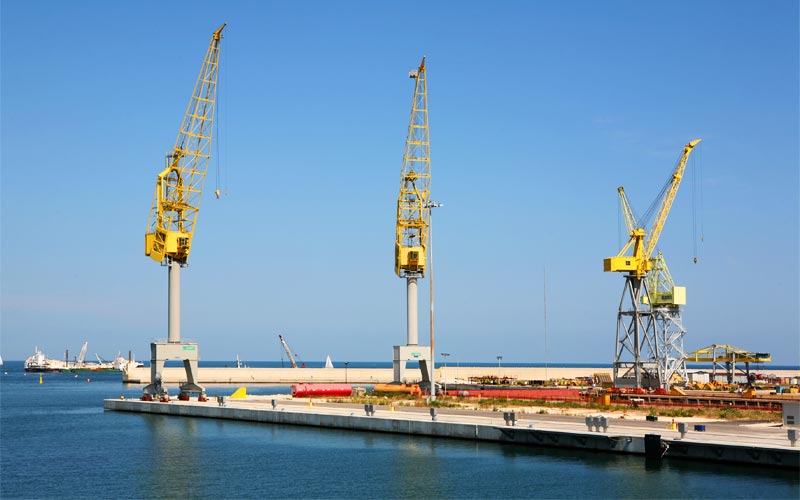Erosion caused by water poses unique challenges for a variety of assets located on rivers, canals, lakes and coastlines. The powerful forces of waves, currents and tides can quickly wash away soil and displace particles through their movement, undermining the stability of underwater structures such as foundations, pipelines and installations. This natural process requires regular monitoring and maintenance to ensure that erosion and sediment control measures remain effective over time in the dynamic underwater environment.
When a major port authority on the U.S. Gulf coast needed an alternative method to traditional concrete revetments or rip rap for erosion and sediment control of its wharf fender system, Underwater Construction Corporation (UCC), a leader in marine construction and rehabilitation, was contracted to help solve the challenge.
The Challenges of Existing Rip Rap Solution
Rip rap, a loose layer of large stone and rock, had been previously placed along the wharf’s embankment for shore stabilization, and was damaging the protective coating of the dock pilings. While a common method for erosion and sediment control, rip rap can cause several problems to piling coatings both above and below the water, due to the constant abrasion of the rocks against the protective materials. This can lead to increased corrosion and reduced lifespan of the coatings and, eventually the pilings themselves. The presence of rip rap can also make it challenging for dive teams like UCC’s to visually inspect and assess possible coating damage, which could impede proper maintenance and repair efforts.
While placing traditional concrete revetments can be effective for many applications, it does require the construction of an elaborate formwork. When complex geometries are involved, it can be impractical to install standard formwork systems. Even the use of pre-cast concrete units may be unfeasible due to the general absence of a sufficient level subgrade. This solution is typically rejected due to the high risk of underflow or “washing-out,” particularly at the joints.
A Successful CIPABM Erosion and Sediment Control Solution
As Cast-In-Place Articulating Block Mattress was determined to be the most effective erosion control method for the Port Authority’s needs, the UCC team began a three-month planning period during which they conducted site assessments, developed timelines, produced design and installation plans, and more. UCC has found the CIPABM installation processes offers a more practical and reliable means of stabilization for areas that have already suffered or are at risk of erosion, like the one present at this port authority site.
The CIPABM formwork unit consists of two geotextile layers that are interlocked at regular intervals. The layers can be joined together by vertical spacers, or by strapping methods and zipper. With the ability to join each section, there is no limit to the number of adjacent panels, resulting in continuous lengths, a key benefit, for linear structures such as power station canals. In addition to the wide variety of technical benefits, the possibility of using the CIPABM method allows for application in many different structural geometries like stormwater retention basins, overflow sections, port dock bed protection and more.
Expert Cast-In-Place Articulating Block Mattress Installation

UCC’s crew, consisting of a project manager and seven divers, worked on-site for six months to install 53 CIPABMs approximately the size of 20’ wide x 190’ long each. Based on the layout, the team utilized a unique installation process for pumping grout into the CIPABM, allowing flexibility during underwater installation. The team adapted the installation process, which included commercial divers, performed site-specific project planning and implemented detailed project management. Working with support of the customer, UCC successfully completed the project, all while exceeding safety goals.
“UCC staff conducted this project using safe practices that resulted in zero incidents. While onsite, UCC team members planned and executed the tasks set before them daily, keeping the project under budget and on schedule,” said Brandon Wheeler, UCC Texas Operations Manager.
Benefits of CIPABM
CIPABM installation is not only a durable and long-lasting solution, but also a unique and innovative product which can be a cost-effective option for erosion and sediment control. Of note, CIPABM:
UCC is a leading expert in utilizing Cast-In-Place Articulating Block Mattress for a variety of applications, including river and streambank stabilization, shoreline protection and other erosion-prone areas. Whether you have an erosion and sediment control-specific project or have a question about our commercial diving services, our team is ready to help. Reach out today and let’s discuss your underwater diving service needs.
Leader in Underwater Construction
As the largest inland commercial diving services company in the United States, Underwater Construction Corporation and its staff of over 200 divers, supervisors and project managers operate from multiple regional locations in Connecticut, Maryland, Michigan, Tennessee, Wisconsin, Texas, South Carolina and the United Kingdom. Through our global network of offices and associates, UCC has performed projects in over 25 countries. Every job, no matter the size, receives the professionalism customers expect from UCC.
If you have questions regarding erosion and sediment control methods, underwater coatings or carbon wrapping services, fill out the form on this page or contact us at any one of our numerous locations.
